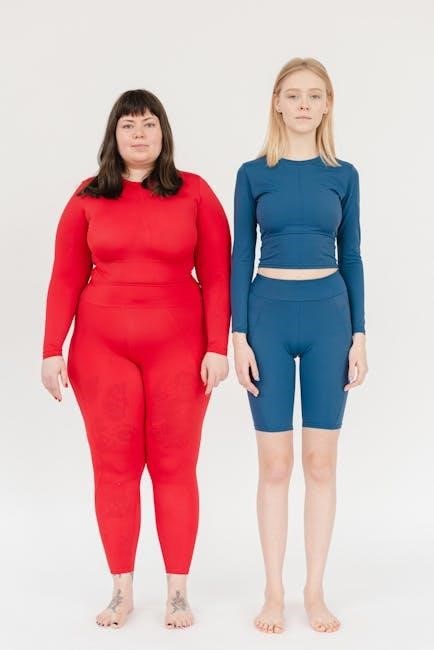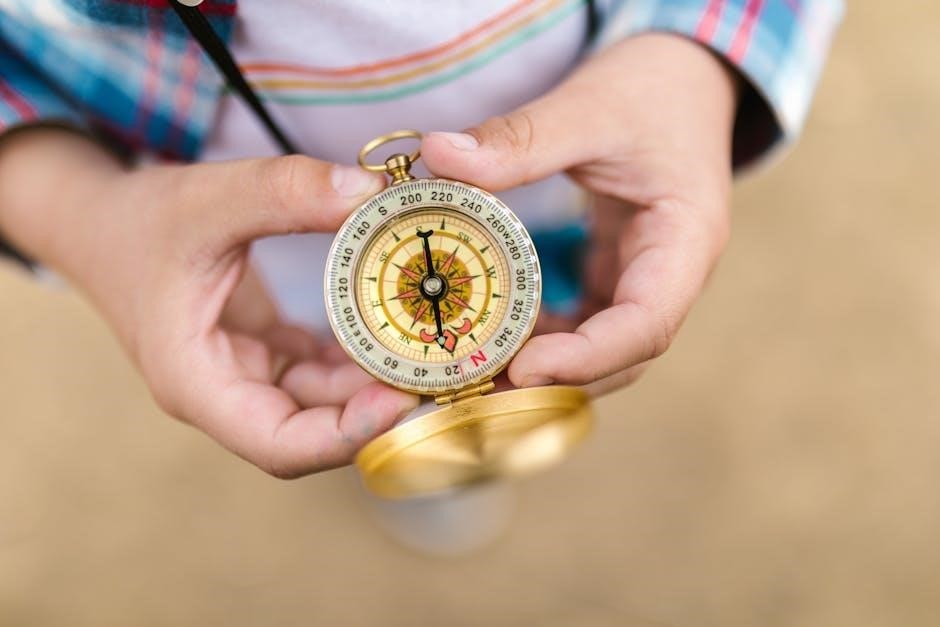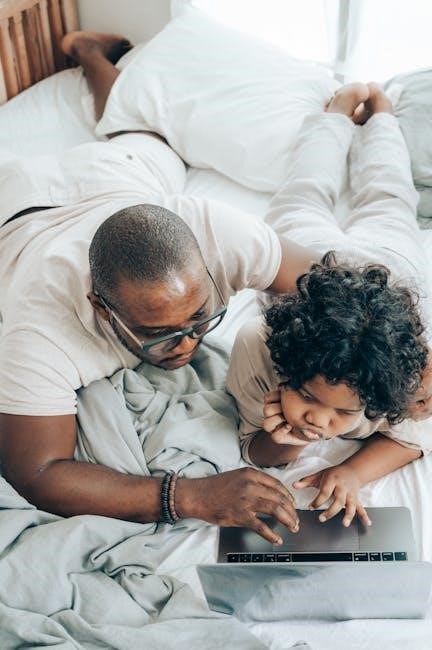size guid

A size guide is a tool to help determine the best fit for clothing, shoes, and accessories by comparing body measurements to standardized charts, ensuring comfort and accuracy.
How to Measure Yourself
To measure yourself accurately, use a flexible tape measure. Start by measuring your bust under the arms, waist at the natural line, and hips 8 inches below the waist. Compare these measurements to size charts for the best fit.
2.1. Measuring Your Bust
Measuring your bust accurately is essential for determining the right clothing size. To do this, wrap a flexible tape measure under your arms and around the fullest part of your bust. Ensure the tape is level and not too tight or loose. The measurement should be taken with the tape measure parallel to the floor. It’s important to stand up straight and relax your shoulders for an accurate reading. If you’re wearing a bra, choose one that fits well and doesn’t add extra padding. Record the circumference in inches or centimeters and compare it to the size chart. This will help you find garments that fit comfortably and provide the right support.
2.2. Measuring Your Waist
To measure your waist accurately, locate your natural waistline, which is the narrowest part of your torso, typically just above your belly button. Wrap a flexible tape measure around this area, ensuring it is level and not twisted. The tape should be snug but not tight, and you should stand up straight during the measurement. Take note of the circumference in inches or centimeters. This measurement is crucial for determining the fit of pants, skirts, and shirts. For the most accurate result, avoid sucking in your stomach or holding your breath. This step is essential for both men and women, as it helps ensure the best fit for a variety of garments.
2.3. Measuring Your Hips
To measure your hips accurately, stand straight and place the tape measure around the fullest part of your hips, typically about 8 inches (20 cm) below your natural waistline. Ensure the tape is level and not twisted. The measurement should be snug but not tight, taken while your feet are together. This measurement is essential for determining the fit of pants, skirts, and dresses. For the most accurate result, avoid tilting the tape measure or holding your breath. If you’re unsure, ask someone to help you for precision. This step is crucial for achieving the best fit in garments that sit on or below the hips, ensuring comfort and proper proportions.
2.4. Measuring Your Inseam
To accurately measure your inseam, locate the starting point at the crotch seam. Stand straight with feet together, ensuring the measuring tape is straight and not twisted. Extend the tape from the crotch down to the ankle bone for the correct length. Use a flexible measuring tape or a string, marking the endpoint and measuring against a ruler if necessary. Avoid slouching and ensure the tape is snug but not tight. Consider shoe height for additional length needs. Measure regularly, especially with weight changes, and refer to brand-specific charts for precise fit. Accurate inseam measurement ensures well-fitting pants, enhancing comfort and style.
Clothing Size Charts
Clothing size charts provide standardized measurements for men, women, and unisex apparel, helping consumers choose the right fit by comparing body measurements to size options.
3.1. Men’s Clothing Sizes
Men’s clothing sizes are typically based on body measurements, including chest, waist, and inseam. These measurements help determine the best fit for shirts, pants, and other apparel. Size charts vary by brand but generally follow standard guidelines. For example, a chest measurement of 40 inches corresponds to a medium or large size, while a 34-inch waist aligns with a medium. Inseam measurements are crucial for pants, ensuring the correct length. Understanding these measurements is key to selecting clothes that fit comfortably. Always refer to a brand’s specific size guide, as sizing can differ slightly. Accurate measurements ensure a proper fit and comfort.
3.2. Women’s Clothing Sizes
Women’s clothing sizes are determined by measurements of the bust, waist, and hips. These measurements are used to create standardized size charts, ensuring a proper fit. Sizes range from XS to XXXL, with each size corresponding to specific inch or centimeter measurements. For example, a bust measurement of 34 inches typically falls into a size medium. Waist and hip measurements are equally important, as they help determine the fit of dresses, tops, and pants. Variations exist between brands and regions, so comparing measurements to a brand’s specific size guide is essential. Accurate sizing ensures comfort and confidence, making it easier to shop online or in-store.
3.3. Unisex Clothing Sizes
Unisex clothing sizes are designed to fit both men and women, offering a universal fit based on standard measurements. These sizes typically range from Small to XXX-Large, with measurements focusing on chest and waist circumference. For example, a Small unisex shirt might have a chest measurement of 36-38 inches, while an XX-Large could be 48-50 inches. Unisex sizes are ideal for garments like T-shirts, hoodies, and jackets, where a relaxed fit is desired. To ensure accuracy, measure around the fullest part of the chest and the natural waistline. Unisex clothing provides versatility and comfort, making it a popular choice for casual wear. Always refer to the specific size chart for the best fit, as variations may occur between brands.
Size Conversion Across Regions
Clothing sizes vary significantly across regions, with different standards in the US, EU, UK, and other countries. Use conversion charts to ensure accurate size matching when shopping internationally.
4.1. US to EU Size Conversion
Converting clothing sizes between the US and EU systems requires careful comparison, as there is no direct one-to-one correlation. For example, a US size 8 in women’s clothing typically corresponds to an EU size 38, while a US size 10 equates to an EU size 40. Men’s sizes also differ, with a US medium often aligning with an EU medium but varying slightly by brand. Shoe sizes follow a similar pattern, with US sizes running smaller than EU sizes. To ensure accuracy, refer to detailed conversion charts that list measurements in inches and centimeters. This helps bridge regional sizing differences and avoids mismatches when shopping internationally.
4.2. UK to US Size Conversion
Converting UK sizes to US sizes involves understanding the differences in their numbering systems. For women’s clothing, a UK size 10 corresponds to a US size 6, while a UK size 12 aligns with a US size 8. Men’s sizes follow a similar pattern, with a UK medium typically matching a US medium. However, variations can occur between brands, so it’s essential to consult specific conversion charts. Shoe sizes also differ, with UK sizes running smaller than US sizes by about 1-2 sizes. To ensure accuracy, refer to detailed size guides that list measurements in inches and centimeters. This helps bridge regional sizing differences and ensures a proper fit when shopping across borders.
4.3. Other International Conversions
Beyond the US and UK, other countries like Europe, Australia, Canada, Japan, China, and Mexico have their own sizing systems. European sizes often align closely with UK sizes but may vary slightly. For example, a European size 36 corresponds to a US size 6 for women. Shoe sizes also differ, with European sizes being numerical rather than letter-based. Australia follows a similar system to the UK, while Canada aligns closely with the US. Japan and China use unique metrics, often requiring careful conversion. Mexico and other Latin American countries may follow either US or European standards. Consulting detailed conversion charts is essential to ensure accuracy, especially for in-between sizes. Always check brand-specific guides, as variations can occur.

Understanding Fit and Comfort
Understanding fit and comfort is essential for choosing the right size. Knowing your body type and personal comfort preferences helps in selecting garments that flatter and relax. While fit can vary between brands, using size guides ensures the best possible fit for your unique measurements and style.
5.1. Determining Your Body Type
Determining your body type is crucial for selecting clothes that flatter your figure. Common body types include pear-shaped, apple-shaped, hourglass, rectangular, and inverted triangle. Each type has distinct characteristics:
- Pear-shaped: Curvier hips and thighs, narrower bust and shoulders.
- Apple-shaped: Fuller midsection, slimmer limbs.
- Hourglass: Balanced bust and hips with a defined waist.
- Rectangular: Similar measurements throughout, with little waist definition.
- Inverted triangle: Broad shoulders and bust, narrower hips.
Understanding your body type helps you choose styles that accentuate your strengths and balance proportions. Use this knowledge to select sizes and fits that complement your natural shape for optimal comfort and confidence.
5.2. Choosing the Right Fit
Choosing the right fit involves balancing comfort, style, and functionality. Start by ensuring your measurements align with the size chart for accurate sizing. Consider your body type and how clothes drape on your frame. Avoid tight clothing that restricts movement, as well as overly loose styles that lack shape. For example, if you prefer a relaxed fit, size up; for a snug look, size down. Pay attention to fabric stretch and activity-specific designs, such as athletic wear requiring a closer fit. If you’ve gained or lost weight, reassess your size to maintain comfort. Remember, the right fit enhances confidence and ensures optimal wearability without compromising style or practicality.
Importance of Accurate Sizing
Accurate sizing is crucial for ensuring customer satisfaction, reducing returns, and building trust in a brand. Proper fit enhances comfort and confidence, making the purchase more enjoyable. Incorrect sizing leads to dissatisfaction, higher return rates, and additional costs for businesses. It also fosters a negative perception of the brand. By providing precise measurements and clear size guides, companies can minimize sizing errors and improve customer loyalty. Accurate sizing also supports sustainability by reducing waste from returns and exchanges. Ultimately, it creates a seamless shopping experience, especially online, where customers rely solely on size charts to make informed decisions. Prioritizing accurate sizing benefits both businesses and consumers alike.

Common Mistakes to Avoid
When using size guides, common mistakes include incorrect measuring techniques, such as using a loose or tight tape measure, which can lead to inaccurate sizing. Many individuals assume that sizes are consistent across brands, but variations in sizing standards can result in poor fits. Neglecting to consider body type is another error, as garments are designed for specific shapes. Additionally, failing to update measurements after weight changes or ignoring international size differences can lead to dissatisfaction. Relying solely on previous purchases without checking current size charts is also a mistake. Avoiding these errors ensures a better fit, enhances comfort, and improves overall shopping satisfaction.

Specialized Size Guides
Specialized size guides cater to specific needs, such as petite, tall, maternity, and plus-size individuals, ensuring proper fit and addressing unique requirements for various body types and preferences.
8.1. Petite Size Guides
Petite size guides are specifically designed for individuals with a shorter stature, typically under 5’4″, ensuring clothing fits proportionally. These guides focus on adjusted measurements for inseam, sleeve length, and body proportions. Unlike standard sizes, petite sizing isn’t just smaller versions but tailored to fit shorter frames. To measure accurately, focus on inseam, sleeve length, and natural waistline. Petite sizes often feature shorter hems, sleeves, and pant legs for a better fit. When shopping, look for brands offering dedicated petite collections. Consider alterations if needed for the perfect fit. Accurate petite sizing ensures comfort and style, avoiding overly baggy or disproportionate clothing. This guide helps petites find flattering and well-fitting garments effortlessly.
8.2. Tall Size Guides
Tall size guides cater to individuals with taller statures, typically over 5’8″ or 5’10”, ensuring proportional fit in clothing. These guides focus on extended inseam, sleeve length, and overall body proportions. Unlike standard sizes, tall sizing adjusts for longer limbs and torso, providing comfort and style. To measure accurately, focus on inseam, sleeve length, and body proportions. Tall sizes often feature longer hems, sleeves, and pant legs for a balanced fit. When shopping, look for brands offering dedicated tall collections. Consider alterations if needed for the perfect fit. Accurate tall sizing ensures comfort and style, avoiding overly short or disproportionate clothing. This guide helps taller individuals find flattering and well-fitting garments effortlessly.
Children’s Size Guides
Children’s size guides are designed to help parents find the perfect fit for their kids’ clothing, shoes, and accessories. These guides typically organize sizes by age, height, and weight, ensuring garments accommodate growth and comfort. Key measurements include chest, waist, hips, and inseam. Accurate sizing is crucial for comfort and mobility, especially for active children. When measuring, use a flexible tape measure and ensure the child stands straight. Size charts vary by brand, so always refer to specific guides. Proper fit prevents restrictive clothing and ensures durability. By following children’s size guides, parents can make informed purchases, reducing the need for returns and ensuring their kids feel comfortable and confident.
Maternity Size Guides
Maternity size guides are tailored to accommodate the changing body during pregnancy, ensuring comfort and flexibility. These guides typically use standard clothing sizes but are designed to fit a growing belly. Measurements focus on bust, natural waist, and hips, with some brands offering specific maternity sizes. When measuring, use a flexible tape measure and stand straight. Fabric stretch and style also influence fit, so consider these factors. Accurate sizing ensures comfort and prevents restrictive clothing. Always refer to brand-specific maternity size charts, as they may vary. Proper fit is essential for mobility and confidence during pregnancy; By following maternity size guides, expectant mothers can find flattering and comfortable clothing that adapts to their changing body.
Plus Size Guides
Plus size guides cater to individuals with larger body types, ensuring a comfortable and flattering fit. These guides extend standard size charts to include larger measurements, often labeled with plus sizes (e.g., 1X, 2X, 3X). Measurements typically focus on bust, waist, and hips, similar to standard sizing charts. The key is to ensure the garment fits well without being restrictive. Many brands offer detailed plus size guides to help customers find their ideal fit. Accurate measurements are crucial, as plus sizes can vary significantly between brands. Always refer to the specific brand’s size chart for the best results. Proper sizing ensures both comfort and confidence, making plus size guides an essential tool for inclusive fashion.
Shoes and Accessories Size Guides
Shoes and accessories size guides provide detailed measurements to ensure the perfect fit for footwear, hats, belts, and more. These guides often include international size conversions, such as US, EU, and UK sizes, to accommodate global shoppers. Measuring techniques may vary; for shoes, length and width are key, while hats and belts rely on head or waist measurements. Many guides use standardized charts to help customers match their body measurements to the correct size. This reduces the risk of ill-fitting items and returns. By following these guides, shoppers can confidently purchase shoes and accessories online, ensuring comfort and style. Accurate sizing is especially important for footwear, where even small discrepancies can affect comfort.

International Size Standards
International size standards aim to create consistency in clothing and footwear sizing across different countries and regions. These standards help consumers shop confidently worldwide by providing uniform measurements. While size labels vary between regions, such as US, EU, and UK sizes, standardized charts offer conversions to ensure accuracy. For example, a size 8 in the US may correspond to a size 38 in the EU. These systems reduce confusion and errors when purchasing items from global brands or online retailers. By adhering to international size standards, shoppers can rely on consistent fits, regardless of the country of origin. Accurate measurements and clear conversions are key to making these standards effective and reliable for everyone.
Brand-Specific Size Guides
Brand-specific size guides are tailored to fit the unique designs and sizing systems of individual brands. While general size charts provide a baseline, many brands develop their own sizing standards to reflect their target audience, fabric types, and style aesthetics. For instance, brands like Nautica and ASOS offer detailed size guides specific to their clothing lines, ensuring customers find the perfect fit for their particular products. These guides often include measurements for bust, waist, hips, and other relevant body points. By referencing brand-specific sizing, shoppers can avoid discrepancies and make more informed purchasing decisions. Always check the brand’s size guide before ordering, as sizing can vary significantly between brands.

Using Size Guides for Online Shopping
Using size guides is essential for online shopping to ensure a perfect fit without the ability to try clothes on. Measure your bust, waist, and hips accurately, then compare these measurements to the size charts provided by the retailer. This helps avoid sizing errors and reduces the likelihood of returns. Many brands, such as ASOS and Nautica, offer detailed size guides specific to their products. Consider your body type and recent weight changes when selecting sizes. For the best fit, choose clothing that aligns with your measurements and desired comfort level. Online size guides also include international conversions, making it easier to shop from global brands confidently.

Technologies in Size Guiding
Modern technologies have revolutionized size guiding, enhancing accuracy and personalization. Tools like 3D body scanners and augmented reality (AR) apps allow customers to create precise virtual models, ensuring a perfect fit. AI-powered algorithms analyze body measurements and preferences to recommend sizes tailored to individual needs. Virtual try-on features enable users to visualize how clothes fit without physical trials. Machine learning systems improve size predictions by analyzing customer data and feedback. These innovations reduce returns, enhance shopping experiences, and make size guiding more accessible and efficient. Advanced technologies are transforming the way consumers interact with size charts, offering a more customized and reliable approach to finding the right fit.
Custom and Bespoke Sizing
Custom and bespoke sizing offers tailored solutions for individuals seeking precise fits. Unlike standard sizing, bespoke sizing involves creating garments to exact body measurements, ensuring a flawless fit. This method is ideal for those with unique body types or specific style preferences. Advanced tools like 3D scanning and made-to-measure software enable precise calculations, while personalized consultations with tailors guarantee attention to detail. Custom sizing minimizes alterations and returns, providing a seamless shopping experience. By combining traditional craftsmanship with modern technology, bespoke sizing delivers superior comfort, quality, and personalization, catering to discerning customers who value exclusivity and perfection in their attire.

Cultural Differences in Sizing
Cultural differences significantly influence clothing and shoe sizing standards worldwide. Various regions have distinct measurement systems, reflecting local body types, preferences, and lifestyles. For instance, Asian sizing tends to run smaller compared to US or EU sizes, while some cultures prioritize looser fits for comfort. These variations affect both consumers and manufacturers, as sizing charts must adapt to regional preferences. Additionally, cultural perceptions of body image and fit play a role in how sizes are labeled and perceived. Understanding these differences is crucial for accurate sizing, especially when shopping internationally. Clear communication and adaptable size guides help bridge these gaps, ensuring a better fit across diverse markets and preferences.
Historical Evolution of Size Guides
The concept of size guides dates back to early tailoring, where measurements were taken individually to create custom-fit garments. Standardized sizing emerged during the Industrial Revolution, enabling mass production. Initially, sizes varied widely, with no universal system. In the mid-20th century, the U.S. introduced voluntary standards for clothing sizes, followed by other regions adopting similar systems. Over time, advancements in technology and global trade led to more precise measurements and international size charts. Despite these improvements, inconsistencies remain due to differences in manufacturing techniques and body types. Today, size guides continue to evolve, incorporating digital tools and AI for better accuracy, ensuring a more personalized fit for diverse populations worldwide.

Environmental Impact of Sizing
Clothing sizing practices significantly impact the environment, primarily through waste and pollution. Returns due to incorrect sizes generate massive carbon emissions from shipping and packaging. Overproduction to meet diverse size demands depletes resources and increases textile waste. Synthetic fabrics, often used in fast fashion, release microplastics during washing, harming ecosystems. Additionally, the dyeing and treatment processes for garments contribute to water and air pollution. Accurate sizing can mitigate these issues by reducing returns and overproduction. Brands adopting sustainable materials and practices, such as virtual try-ons and 3D scanning, help minimize waste and emissions. Promoting ethical sizing practices supports a more environmentally friendly fashion industry, aligning with global sustainability goals.
Legal and Ethical Considerations
Clothing size guides raise legal and ethical concerns, particularly regarding transparency and fairness. Inconsistent sizing across brands can mislead consumers, leading to dissatisfaction and returns. Ethically, accurate sizing ensures inclusivity, avoiding discrimination based on body type or size. Brands must comply with consumer protection laws, ensuring clear and truthful sizing information to avoid misleading claims.
Additionally, ethical practices involve promoting sustainability by reducing waste from incorrect sizes. Brands should adopt standardized sizing charts and transparent labeling to foster trust. Legal frameworks often require clear sizing disclosures, while ethical considerations emphasize fair labor practices in production. By prioritizing accuracy and inclusivity, brands align with both legal obligations and ethical standards, fostering a responsible fashion industry.

Future Trends in Sizing
The future of sizing is poised for significant advancements, driven by technology and evolving consumer demands. AI-powered size recommendation tools are becoming more prevalent, using body measurements and fit preferences to suggest sizes. 3D scanning and augmented reality (AR) are also transforming how consumers determine their sizes, offering virtual try-ons and personalized fit assessments.
Sustainability will play a key role, with brands adopting sizing strategies to minimize waste and returns. Inclusivity is another trend, with extended size ranges and gender-neutral options gaining traction. Additionally, blockchain technology may emerge to standardize sizing globally, ensuring consistency across brands and regions.











































